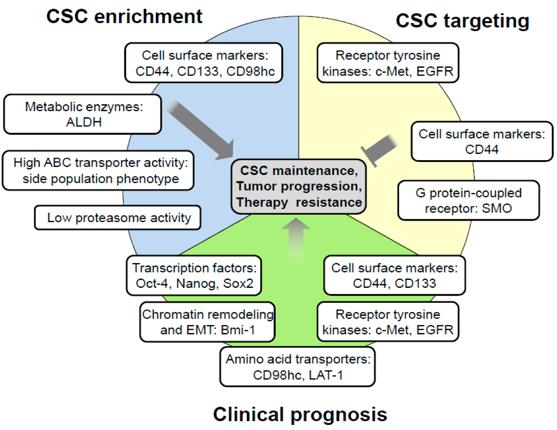Head and Neck Cancer Stem Cell Markers
Related Symbol Search List
Immunology Background
Overview of Head and Neck Cancer Stem Cell Markers
Head and neck cancer stem cell markers are markers that characterize stem cells in patients with head and neck cancer. Recent studies have shown that the development and recurrence of head and neck cancers are associated with the presence and activity of tumor stem cells. Therefore, researchers have determined their presence in cancer stem cells by analyzing the expression of specific stem cell markers in head and neck tumor tissues, and commonly used markers include CD44, CD133, and ALDH1 (as shown in Figure 1). These research methods, including flow cytometry, immunohistochemistry, and quantitative PCR, can be used to detect the expression levels of stem cell markers, and to isolate and purify cancer stem cells for further study of their functions and regulatory mechanisms. The study of head and neck cancer stem cell markers provides insights into the specific proteins or molecules expressed on the surface of these cells, which play an important role in understanding the biology of cancer stem cells, their origins, their ability to proliferate and differentiate, their resistance to drugs, and the process of tumor progression and metastasis, thus helping to identify and isolate subpopulations of head and neck cancer stem cells and providing more targeted targets and strategies for future therapeutic strategies and research.
 Fig.1 Selected markers for cancer stem cell (CSC) enrichment, targeting and prognostication in head and neck squamous cell carcinoma (HNSCC). (Peitzsch, C., et al., 2019)
Fig.1 Selected markers for cancer stem cell (CSC) enrichment, targeting and prognostication in head and neck squamous cell carcinoma (HNSCC). (Peitzsch, C., et al., 2019)
Research Areas of Head and Neck Cancer Stem Cell Markers
- Characterization of head and neck cancer stem cells
Researchers can further study the characteristics of head and neck cancer stem cells, including self-renewal ability, non-differentiation potential and multidirectional differentiation potential. This could involve further validation of stem cell markers in combination with other molecular characterization and functional experiments to confirm the stem cell properties of these cells.
- Molecular mechanisms of head and neck cancer stem cells
Researchers can study the molecular mechanisms of head and neck cancer stem cells, including gene regulatory networks, signal transduction pathways, and the tumor microenvironment. This helps to understand the functions and roles of stem cell markers in cancer stem cells, as well as their relationship with tumor development and drug resistance.
- Development of new therapeutic strategies
By further expanding the study of stem cell markers in head and neck cancer, new therapeutic targets and strategies can be identified. For example, by developing specific antibody drugs, small molecule inhibitors, or interfering RNAs against these markers, head and neck cancer stem cells can be targeted for elimination and improved therapeutic efficacy. In addition, the potential of stem cell markers as biomarkers for predicting prognosis and response to treatment in head and neck cancer patients could be explored.
- Cancer stem cells and metastasis
Researchers can further investigate the relationship between head and neck cancer stem cells and tumor metastasis, which includes studying the expression and function of stem cell markers during metastasis, as well as their role in lymph node metastasis, blood circulation metastasis, and distant organ metastasis. By gaining a deeper understanding of the metastatic mechanisms of head and neck cancer stem cells, new targets and strategies can be provided for the prevention and treatment of metastatic head and neck cancer.
- Tissue engineering and regenerative medicine
Using the properties of head and neck cancer stem cells, researchers can explore their applications in tissue engineering and regenerative medicine. This includes the use of head and neck cancer stem cells to construct simulated tissue and organ models for research in areas such as new drug screening, disease simulation, and individualized medicine.
The study of stem cell markers for head and neck cancer is of great significance in the field related to head and neck cancer. Through its in-depth study, it can provide a theoretical basis for the individualized treatment strategy for head and neck cancer and promote the development of new therapeutic methods. It is believed that with the deepening of scientific research, the treatment level of head and neck cancer will be further improved, bringing more hope and welfare to patients.
Reference:
- Peitzsch, C.; Nathansen, J.; Schniewind, S.I.; Schwarz, F.; Dubrovska, A. Cancer Stem Cells in Head and Neck Squamous Cell Carcinoma: Identification, Characterization and Clinical Implications. Cancers 2019, 11, 616. https://doi.org/10.3390/cancers11050616

